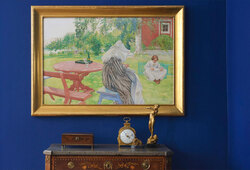Anton (Antoine) Mirou
Landscape with hunters
Copper plats 47 x 63 cm. One of the dog's collar signed F.P.C. A verso marked no 68.
Alkuperä - Provenienssi
Christie's, London, 9 dec 2005, cat. nr 115.
Muut tiedot
Antione Mirou's date and place of birth have not been determined with certainty, however, around 1580 several artists of that name were registered in Antwerp's guild of St. Luke. Yet, by 1586 his father Hendrick, an apothecary, appeared for the firts time in records in Frankenthal. Like many other Protestants in Flanders and Brabant at the time, Hendrick Mirou and his family left Flanders to escape religious persecution, taking refuge in Frankenthal where they came under the protection of the steadfast Calvinist, Frederich III, the Elector Palatine.
Mirou was one of the most accomlished of the landscape artist of the Frankenthal School. The best known painter of the group was Gillis van Coninxloo, and Antoine may have been his pupil, although no records supporting this have been identified. In 1602 Antoine marries Suzanna van Coninxloo, and he is mentioned often in the city archives until 1620, when he is presumed to have returned to Antwerp.
Mirou's early work shows the stron influence of Coninxloo, especially in the compositional structure of his works as well as the repeated use of specific picturesque motifs such as rock fortress, waterfalls, high bridges, and hunters. The traditional division of the works into a brown foreground, green middle ground and a bluish background is onother element of his work reminiscent of the works of Coninxloo, and the predominance of blue and green tonalities sessn in his work, as well as meticulous attention to detail are in keeping with the traditiondeveloped by followers of Jan Breughel ("Velvet" Breughel). Mirou's work shares many similarities with that of Pieter Schoubroeck, another Frankenthal artist strongly influenced by Coninxloo.
Prior to 1614 most of Mirou's paintings were of forest landscapes, which included fantastic and romantic elements that show his considerable dept to van Coninxloo. After that date Mirou was in process of developinghis own mature personal style and was restricting his subject matter to village scenes, which often consisted of a road passing through a village with rustic houses on each side and forest covered hillsides in the background. He commonly employed numerous figures performing a myriad of activities to enliven these engaging scenes.
Dr Luuk Pijl and Michel Kervyn de Meerendré have confirmed the attribution of the present painting to Antoine Mirou, the latter dating the picture to circa 1610-20. The composition perfectly reveals Mirou at this transitional point in his career, just as he was moving from his total focus on forest scenes to a newfound attention to scenes of village life. The present work is effictively devided by a group of trees in the centre, with the forest seen on the left and view of a village seen to the right. The recession into space is defined in the traditional way with bands of colour and light, a device commonly used by Mirou at this time and seen for instance in the "Wooded Landscape" in the Staatsgalerie, Stuttgart, and in the "Village by a Wood" in the Statens Museum for Kunst, Copenhagen.
The intriguing detail of the initials "F.P.C" seen on the collar of the dog is a subject for future stydy and may well ultimately reveal the patron who commissioned the work.
































